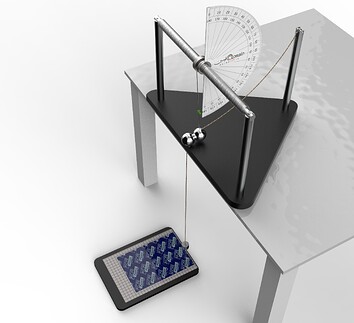Investigating the principle of energy conservation through the collision of two objects moving in 2-D.
Overview
• Simple tabletop setup to observe energy conservation in 2D.
• Fully translational and nearly elastic collision between two balls.
• Complete cycle of data recording, processing, and plotting.
• Motivates students to investigate discrepancies between theoretical predictors and experimental observations.
• Applying equations of motion.
• Calculating Uncertainty.
How does it work?
The experimental setup comprises two parts:
- The first one consists of two metallic balls of nearly equal masses. One of them is attached to a thin rod connected to a bearing to form a relatively low-loss pendulum. The second ball is placed on a tee to be struck by the pendulum, which is held at its highest position by a thread that goes over a pulley.
- The second part, the floor stage, is placed right below the table. When the untethered ball is struck by the pendulum, it flies off the tee and drops onto the piece of carbon paper laid on the floor stage. It leaves a small mark on the graph paper, which is used to record the position of the ball.
Using basic equations of motion, the formula connecting the distance covered by the free ball and the angle of the pendulum is derived, results are plotted and compared.
Parts included
- Spherical Metal Ball
- The Pendulum Assembly:
The main stand holding the pendulum and the protractor, a pulley for the thread, a tee to hold the free ball before the collision, and a screw to adjust the level of the pendulum. - Floor Stage:
A wooden stage to place the carbon paper on for recording the position. - Thread:
For plumb line and holding back the pendulum.
>You can get the PDF version of the brochure by clicking on this link.

